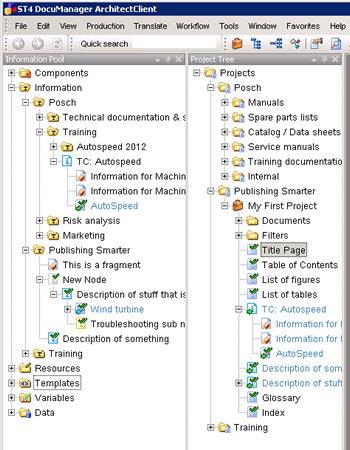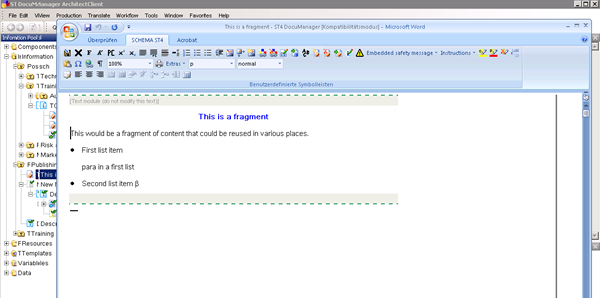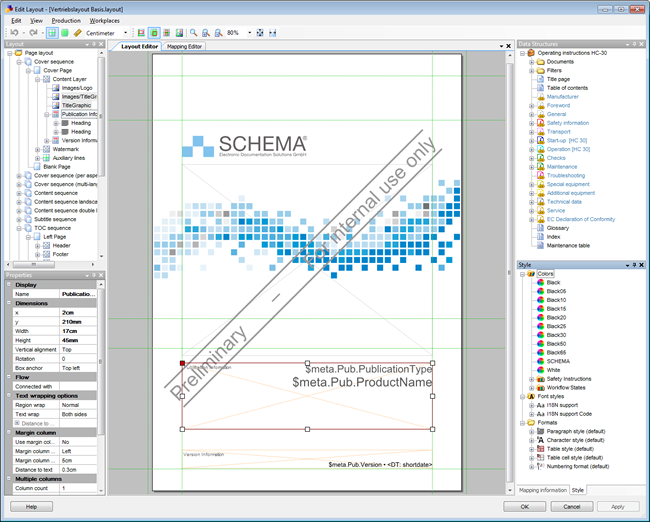 A component content management system (CCMS) manages content at the sub-document level, allowing amazing versatility in reuse and workflow at the component level (like paragraphs, lists, graphics). Schema is a German company that has oodles of clients in Europe and Asia but has just entered the North American market with its ST4 CCMS. I put ST4 through its paces this spring and, to put it simply, they offer the best CCMS I’ve ever seen.
A component content management system (CCMS) manages content at the sub-document level, allowing amazing versatility in reuse and workflow at the component level (like paragraphs, lists, graphics). Schema is a German company that has oodles of clients in Europe and Asia but has just entered the North American market with its ST4 CCMS. I put ST4 through its paces this spring and, to put it simply, they offer the best CCMS I’ve ever seen.

The Architect Client, the most powerful Schema ST4 client, has a familiar and usable interface.
Right now, Schema’s clientele centers on the healthcare and medical devices, automotive, and electronics sectors, although they have clients from a variety of other industries as well. The interface, to give you a hint about the diversity of its user base, is available in four different languages (English, French, German, and Japanese).
There is much I love about this product, from its easy-to-use interface to the way it can create tables of information from raw data. But by far the most important thing to me in a CCMS is that it stores content only once and you leverage it however and wherever you need it. And this is Schema’s mantra—content (or even data) exists in one place, but can be used whenever and wherever needed.
Two of the biggest differentiators that puts ST4 head and shoulders above all of its competitors include:
- Authors can use Word to author (they can also use XML editors if they are more technical).
- PDF formatting can be done inside ST4 with a WYSIWYG Page Layout Designer, and even on the fly (for example, you can choose to break a page in a specific PDF at a particular spot with a right click).

Authors can create and edit content in Microsoft Word on a special Schema ST4 tab.

Layout Designer: Schema ST4 has its own PDF renderer.
What about DITA?
ST4 can import and export DITA, but it doesn’t use DITA internally. For example, instead of using the DITA keyref mechanism, ST4 has its own built in variable tables that let you swap information around on the fly. The result is the same (or even more impressive), but the method is different.
This product essentially replaces the need for DITA at all, using its own technology to solve the same problems, but then takes it one step further with content management, workflow, stylesheet editing, and taxonomy all built in. Although quite powerful and effective, the technology is proprietary to Schema, which can present some significant management challenges for many organizations.
Advantages
ST4 offers some very impressive features. Usually, in reviews like this, I can point out three or four features that are the strengths of the system. In ST4, you’ll find quite few more than that:
- Author in Word (and/or XML editors).
- WYSIWYG Page Layout Designer that lets you use page and stylesheet designs for PDF, InDesign, and MS Word outputs, as well as a layout designer for FrameMaker MIF and HTML. HTML5 is coming soon.
- Very robust translation and localization management.
- Extensive and robust workflows, with standard workflows available out of the box.
- Impressive graphics and callouts features (callouts are just a layer of data on an SVG graphic, all done from within the system).
- Taxonomy and classification management (complex but complete).
- Web-based access for reviewers.
- Ability to extend or customize the underlying information model.
- Roles and rights management centralized and capable of integrating the LDAP.
- An active and engaged user community (although mostly in Europe as of 2014).
Disadvantages
Yes, ST4 does have a few disadvantages that can put it out of reach for some organizations:
- Price: You’re going to pay between €835 and €12,000 for people who need to access the system, depending on which role they’ll have. A reviewer role, for example, would cost €2,500 for 3 licenses. However, all licenses are concurrent or floating, so if you have global users, you’ll need fewer licenses than people. [As of June 1, 2014, €1=$1.36 US.] I’ve found that this pricing is in line with the other big CCMSs that pack in almost as much functionality, including SDL, Ixiasoft, and Vasont.
- Complexity: If you’re looking for an easy-to-learn system, this is not it. Its complexity means that you have to take the time to learn it properly. For example, basic training to get me up and running lasted six hours and could easily have gone another day for hands-on activities. Advanced functionality like workflow and document design require more days of specialized training as well as consultant help.
- Proprietary database and information model: ST4 is built from the ground up on a proprietary system. Everything from the taxonomy management to the PDF renderer is owned, managed, and updated by Schema. There’s no open source here.
Overall
You’ll need a healthy budget and an appropriate ROI, but the Schema ST4 solution is without a doubt the best CCMS I’ve seen to date (and I’ve reviewed a lot of them)—even if it’s not native DITA. It does what DITA does but differently, and better, in some respects. The proprietary nature of the system is a drawback, but Schema ST4 is well suited to highly technical content where you may need to generate tables on the fly, leverage extensive reuse, and translate to one or more languages. It’s also ideal if you have some authors who must work in Microsoft Word and you want easy and complete control over the layout and design of your outputs.